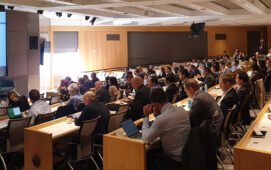When the EU’s wide-ranging Markets in Financial Instruments Directive II (MiFID II) regulation came into force on January 3, 2018, traders did their best to deliver on its transparency demands and ensure they provided best execution on every trade in Europe, across all asset classes. But in justifying their actions to regulators and clients, firms are suffering from a post-January hangover in one particular area: algorithmic trading.
There are two problems. First, algos are a bugbear for regulators. As the Financial Conduct Authority (FCA) recently pointed out, they are increasingly being used to automatically make execution and investment decisions and choose brokers. But while algos increase order speed and cut costs, that same speed and automation can ‘amplify the risk of turning otherwise manageable errors into extreme events’, says the FCA.
So, algos are in the spotlight, with the FCA insisting: “Firms should reference a number of pieces of legislation when developing algorithmic trading practices and procedures, most notably MiFID II.”
Which leads to the second problem: how difficult it is for firms to comply with MiFID II’s demands. Broadly, the regulation requires firms to identify and track all their algo trades, with full oversight and robust development and testing. They should have pre and post-trade risk controls, covering price, value, trade and message volumes, trader permissions, and market and credit risk limits. They must have detailed knowledge of how their algos work and consider the impact of their algo trading on market integrity to reduce market risk. This includes having an emergency kill functionality to instantly cancel unexecuted orders, and a system to prevent incorrect orders contributing to a disorderly market.
Effectively, traders are being asked to make transparent the assumptions baked into what may be a series of connected, complex algorithms, and prove they always use the best algo to drive trades. This includes algo wheels – which add an extra layer of data-driven automation, by making trade and broker decisions based on performance data and transaction cost analysis.
More detailed guidance
Industry experts say that to satisfy all these demands, firms need much more detailed guidance from regulators – clarity that was lacking pre-the MiFID II deadline, and still is.
Will Winzor-Saile, who heads the execution analytics team at executing broker Redburn, says: “Speaking to peers, the industry came to a consensus about what to provide by January 3. For a lot of things coming off the back of MiFID II, you make a judgement call. We can justify that to the regulator, but whether that’s what they expected or not remains to be seen. It’s just lack of clarity.”
In particular, Winzor-Saile says algo testing remains a key area of uncertainty: “The level of requirements we’re getting from regulators is ‘you should be testing your algos, you should be documenting your algos’, which I’d d certainly hope most firms are already doing. Until we get more details on what is a proper test and what isn’t, there hasn’t had to be a huge change from our point of view. Things like formalised testing varies a lot between different providers, different brokers. As an industry, it would be good if there was an agreed ‘this is how we test algos’. It would help encourage a consistent approach. Standardisation is always good, and anything the regulator can do to help that is obviously good.”
Others in the industry share his view. “With algo trading the main problem area is testing,” says Christian Voigt, a senior regulatory adviser at Fidessa focused on automated trading systems. “There are a number of changes that came in with MiFID II, there’s conformance testing, testing for disorderly trading and immediately there’s a question – what is disorderly trading? There’s stress testing – where do I test?
“In the requirements on testing, there is also some flexibility around the proportionality to the business that you are doing. I think it’s common sense that firms that are fully automated should do more testing. But how do you determine is the right level for you? These are quite complex detailed questions and I envisage ongoing discussions about what is the right level for me?”
Taking a similar view, Chris Jackson, head of the execution and quantitative services group at Liquidnet EMEA, believes some MiFID II requirements on algo trading equate to basic best practice, while the more broad-ranging demands will require future debate and discussion for clarification.
He says: “In terms of algo trading oversight and control, MiFID II seems to be doing a good job of promoting a minimum standard of good practice. For any sufficiently sized algo desk, the controls stipulated – in particular, the more mechanical components relating to risk controls and validation – should be existing good practice.
“More challenging, are the broader-themed rules that require a consideration of the impact of an algo on market integrity and its impact on market risk. These requirements cannot simply be hard-coded, but instead necessitate careful thought by managers, which is then minuted. It’s not that these considerations have never been taken into account, more that there has never been a process for organising and recording it.”
How to demonstrate compliance
So, when and where is the required guidance going to come from? In February, the Bank of England’s regulatory body, the Prudential Regulation Authority (PRA), published a consultation paper setting out expectations on firms’ governance and risk management of algo trading. This focuses on the areas where the PRA thinks firms need more clarification on how to demonstrate compliance. This consultation closes on May 7. The PRA also intends to publish a discussion paper on operational resilience during 2018.
Meanwhile, industry groups like the non-profit standards body, the FIX Trading Community, publish MiFID II information and implementation guidelines.The recent FCA report mentioned above also identifies some fairly general problems areas, confirming: “Some firms lacked a suitable process to identify algorithmic trading across their business and did not have appropriate documentation in place to demonstrate suitable development and testing procedures are maintained. In these cases, firms also lacked a robust and comprehensive governance framework.
“Additionally, firms need to do more work to identify and reduce potential conduct risks created by their algorithmic trading strategies. This includes delivering suitable market abuse training for staff involved in the development and implementation processes. Firms also need to consider the potential impact their algorithmic trading activity may have on the fair and effective operation of financial markets.”
The FCA also gives specific examples of good and poor practice across MiFID II’s algo trading requirements. Whether this is detailed enough for traders or not is open to question.
As an example, in the area is MiFID II’s market conduct’ demands, that require firms to consider the possible impact of their algo trading on market integrity, and reduce market abuse risk, the FCA cites as poor practice: “Firms who maintain basic market abuse alerts such as insider dealing or layering and spoofing, but do not consider other types of market manipulation which can be associated with algorithmic trading. For example, momentum ignition, quote stuffing and reference price gaming.”
An example of good practice is: “Firms who consider how they can tailor their monitoring and surveillance systems to specific risks within their algorithmic trading activity and also ensure suitable market abuse training is conducted for all relevant members of staff.”
Algo wheels
Meanwhile, algo wheels present a particular dilemma. They could help compliance in that they embed impartial best execution data to help firms manage brokers and trades. But they may also require more attention and monitoring, based on the FCA’s concerns that more automation equals more risk.
In any case, there’s a view that the industry is going colder on algo wheels. Jackson says: “We’ve definitely seen advantages and disadvantages of the algo wheel process. On one side, the move to a more structured, often randomised, selection process has provided a framework for consistent and unbiased evaluation. On the flip-side, however, we’ve seen several instances where the randomising of trade allocation has been to the detriment of best execution, in that a trader has not been able to apply their knowledge – of either a stock, prevailing market conditions, or the trading characteristics of a particular algo – to the trading decision.”
Market future
Whether or not sufficient detailed guidance emerges, Voigt believes the inevitable long-term impact of MiFID II’s rules on algo trading will be more standardisation and simplification. He says: “The problem now is you have so much regulatory overhead on everything you do with your algo – implementing it, testing it, training, monitoring it, changing it – that a lot of times it is not commercially viable any more to run all these highly complex things. Therefore, firms are looking into standardising and rationalising the way they use algos to meet all those requirements.”
He adds: “The one thing you should always consider is the more complex you make your algo, the more time you need to spend looking at the impact on the trading environment. You need to look at all the different algos you have and acknowledge this algo is more complex because I’m doing more advanced things and therefore I need to manage it more carefully.
“This is what MiFID II wants on algo trading. Regulators want you to have this risk management framework. They’re not necessarily saying this algo needs that amount of attention. They want you to come up with your own risk management process, so you can give proportionate control to everything you do that could be considered algorithmic. The most important thing going forward is standardisation and having a systematic approach on how to manage your algo exposure.”
For Winzor-Saile, while trading and broker firms await more regulatory guidance, they will simply carry on regardless – on the basis that improving algo trading controls is best practice. He concludes: “We’ve learnt from regulations in the past, you’re never going to get 100% clarity, 100% agreement on how they work. We will continue to evolve our risk infrastructure and change management processes along the lines of what we see as best practice. In terms of algos and testing, it’s something we’ve always done. Without further guidance, we continue doing it.”
Subscribe to our newsletter





